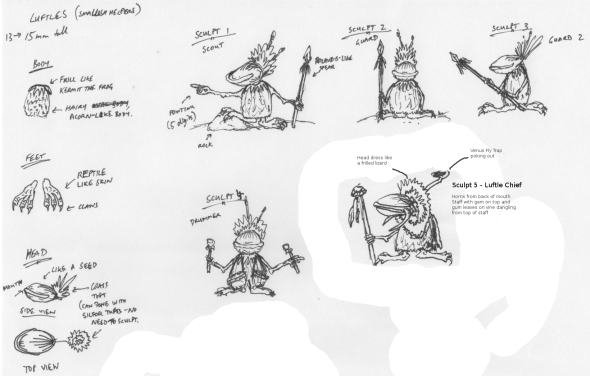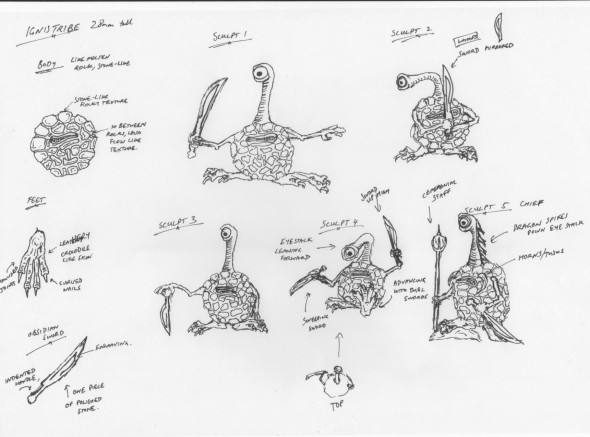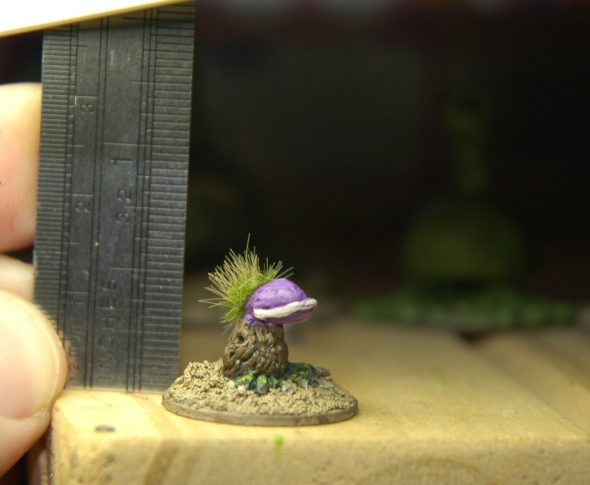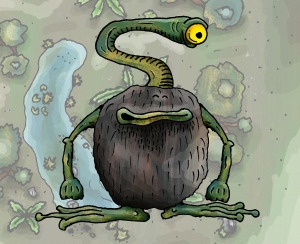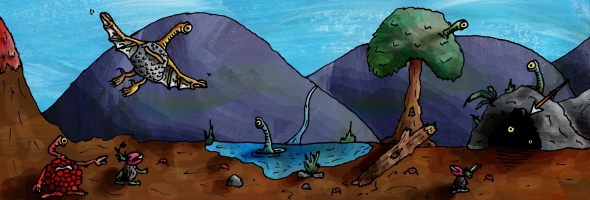A Look at the Campaign System of Dawn
G’day guys,
Today, we are going to take a brief look at the Campaign system in Dawn, how it has changed and why it is a bit different from other games.
When playing a Campaign in Dawn: Rise of the Occulites, we call it playing a Sungem Season. To survive through the Long Dark of the extended nights on Crepusculum (lasting Earth months at a time), the Occulites need to collect Sungems (which are crystals that form in the ground and trap Sunlight within them. This trapped sunlight, gives off a soft light and a warmth that helps keep Occulite Home Caves warm over the Long Dark. Without this warmth, the Occulites will not survive. During a Sungem Season, Occulites also gain experience and learn new skills. The gaining of knowledge and skills is represented in the game by Learned Abilities and by Victory Points.
The Aim of a Campaign in Dawn
The aim of a Sungem Seasons is to gain enough knowledge and skills to survive through the Long Dark, putting them in a strong position for getting a head start on the next Sungem Season they will face. To win a campaign, you not only have to beat other Tribes, but you must actually survive in the first place. Yes, that’s right, there is a chance that at the end of the Sungem Season, your Tribe may not survive the Long Dark and will lose by default. Clever planning and play will ensure though that your Tribe survives. Sungems are important to retain heat in their Home Cave and Victory Points (representing experience) can help your Occulite get the most out of their situation by allowing you to reroll the dice your Sungems give you to create heat at the end of a Sungem Season. The player that has the most Victory Points and has enough Heat from their Sungems to survive, wins!
Innate Abilities
When playing Campaigns, you will usually use the advanced rules for Tribe creation. This allows you to not only choose which Tribe you want to lead, but also allows you to customize their starting statistics.
Once you have chosen a Tribe type, you will be granted some Innate Abilities. Now Innate Abilities are never lost. They are abilities that your Tribe members are born with and these cannot be changed for any reason. You never need to worry about losing them.
Learned Abilities
As you go through the Campaign, your Tribe will earn Sungems and Victory Points. These Victory Points can be spent to recruit Luftles to your Tribe or even gain Learned Abilities.
Now Learning Abilities can be gained in two flavours. They can be gained from the General Ability Pool, which are generic abilities available to each and every Tribe in the game. They are helpful, but aren’t particularly outstanding either. The other option is to spend them on Tribe Specific Learned Abilities. These are abilities that are only available to your Tribe. These are more powerful, but also used in more specific situations. These abilities also encourage the thematic use of your Tribe in game.
Scenario and Situational Abilities
There is also another type of Ability your figures can gain. These are Scenario and Situational Abilities. These are granted to your figures or your Tribe, based entirely on the actions that happen during a Scenario. For example in one of the Scenarios (The Ridge), there is a storm building as your Tribe fights to secure a high up ridge. Lightning splits the air in every direction and there is a chance one or more of your figures will be hit. This is terrible news during this scenario as if they are hit, they are removed from the board and count as being killed. However they then gain the ability ‘Eyebeam’ for the next scenario, a very powerful ranged ability. Another example is in the Podmothine scenario. As both Tribes are fighting against a common enemy, if either Tribe kills another Occulite figure, their Tribe gains the ‘Treacherous’ ability which allows other Tribes to ignore penalties for attacking your Tribe in a scenario. But it also gives you the ability to increase the damage your Tribe does. So what you do in a scenario really does matter! This is also reflected by statistics being awarded to Tribes for doing different things. They are not just automatically awarded.
Choosing a Scenario in Dawn
The combination of these things makes the selection of Scenarios very important. At different points in time, the different Tribes will be wanting different things and so will want to compete in different scenarios. Now, the Base game comes with 11 engaging, challenging and downright fun scenarios, with many different play styles across the board. Choosing which one to play is very important. Players both select a scenario and then refer to the appropriate time of day, adding a number of their Tribal Tokens to a bag which reflects the likelihood of that particular scenario occurring at that time.
For example, in Crepusculum, Nymphlets only spawn towards Dusk. The Scenario Nymphlet Season looks like this: 0 0 0 1 1 2 4 5 5 4
This means that you can’t even play this Scenario in a Campaign until the fourth game and don’t really have a good chance of it being selected until the seventh game. This keeps the world of Crepusculum thematic and make sure that the choices made during a campaign matters. If both players choose the same Scenario, it will automatically be played, but the Tribal Tokens are still added to a bag and are drawn to determine who is the attacker in the Scenario.
Killed Figures during a Campaign
If a figure is killed during a Scenario, it will be ‘Reborn’ in its Home Cave ready for the next scenario. But the Reborn process takes its toll on your figure and because of this, it will always come back a little bit weaker than before. This might cause it to lose a statistic, or sometimes even a Learned Ability, but you still have control even over this with the use of Boost cards from your hand if they are brought back during a Scenario due to the Reborn Track.
Objective Decks
If we can fund the game on Kickstarter and reach our Stretch Goal of $50,000 then we can afford to produce the Objective Decks for each Tribe.
Objective Decks are what they sound like, a small deck of cards that have Objectives that can be completed for benefits during the Scenario, or just held onto for a benefit for the campaign. They can be added to any Scenario, thus greatly enhancing the re playability of all scenarios (which are already very re playable).
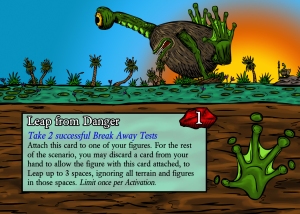 Taking a look at this sample Objective Card “Leap from Danger”, we can see a few things. It is a Palaudis Objective card and thus can only be used by them.
Taking a look at this sample Objective Card “Leap from Danger”, we can see a few things. It is a Palaudis Objective card and thus can only be used by them.
It has some blue text, in this case it reads “Take 2 successful Break Away Tests”. If you are able to successfully do this, you have two options:
1) You can claim the reward listed below that blue text. In this case it awards you a more restricted version of “Leap” a Learned Ability for the Palaudis. Then draw another Objective card Or,
2) You can place the card face down in your play area and draw another Objective Card. At the end of the Scenario, you will gain the benefits in the top right hand corner of the text box. In this case, it would award you 1 Sungem.
As you can see, the decisions made even with how you use the Objective cards is important.
We hope that this little insight into the Campaign System of Dawn – Rise of the Occulites has interested you and perhaps helped you decide to pledge and/or spread the word about the game as it will not be made if we cannot reach our target. We need your help to get Dawn: Rise of the Occulites more exposure, so please consider sharing this with your mates. We would love to have them join the fun!
Cheers,
Ben.
Dawn – Rise of the Occulites Colour Blind Friendly Update

G’day guys,
After testing the old Dawn – Rise of the Occulites cards with some friends that are colour blind, I decided to revamp the card design. The problem was that the numbers in the top, left hand corner whose colour determined whether the cards were BOOST, AGGRESSIVE or DEFENSIVE. They were difficult to tell apart (especially the blue and red of the DEFENSIVE and AGGRESSIVE). The new cards will differentiate this by a symbol behind a white number. There is a Spearhead for AGGRESSIVE, a Shield for DEFENSIVE and a Yellow Occulite Eye for BOOST cards.
The updated cards will each have a different illustration that reflects what the Card Effect is. This will also introduce a little bit more thematic flavour into the cards and hopefully immerse the players in the Occulites universe a bit more.
Below you can see a side by side comparison of the four different iterations the Dawn – Rise of the Occulites cards have gone through.
I hope you enjoy the trip down memory lane… stay tuned for more exciting news coming soon!
Cheers,
Ben.
Video sneak peek at gameplay explanation of Dawn
G’day guys,
Just a quick update today to upload a video demonstration of some of the gameplay in Dawn – Rise of the Occulites.
I hope you enjoy watching it and that it sparks further interest in the game for you. Any questions, feedback or comments are gratefully received. 🙂
Please note that the Natural Selection Deck in the video is just for playtesting. On release the Natural Selection Deck will be printed as a proper card deck.
Cheers,
Ben.
Dawn’s Natural Selection Deck Preview
G’day guys,
I thought it was time to upload a sample card from the Natural Selection deck.
Please bare in mind that the graphics are still a work in progress and they may change for the final game. We’ve been using these graphics and found it to be clean and easy to read, with the interest of the bottom runner, but as you can see I need to change my name to Darwin Games and refine these a bit. But it should give you the general idea.
![[image] [image]](https://riseoftheocculites.files.wordpress.com/2011/07/dawn-rise-of-the-occulites-card-09-of-54.png?w=400)
There are several different parts to the card, some particular parts having multiple uses. The way these cards are used adds a solid tactical nature to the game, creating a depth that rewards good strategy, careful choices and good timing.
Natural Selection cards are either played from your hand of seven cards, or you can “Let Nature Take Its Course” and play the top card from the Natural Selection Deck (however, you won’t actually know what it is).
Natural Selection cards are used when moving over special terrains, when completing objectives, performing special actions and fighting. The Natural Selection Deck also includes Boost cards (modifiers for regular NS cards), Predator cards (which will unleash a predator onto the board), Event cards (which will modify the gaming environment) and Sungem cards (which generates Sungems on the board mid-game). Of course you can tailor your games to your liking, taking out or adding any of these types of cards (which will determine a scenario’s Threat rating and can give bonuses in campaigns). But I’m getting ahead of myself. 😉
The regular Natural Selection cards have a large number in the centre top. That will either be red or blue. In anything but fighting and some special abilities, the colour means nothing and the value is read as just a number. When in combat, the colour is important. If you are attacking, you want to use a red number, in defense you want to use a blue number. You can use a blue to attack and a red to defend, but the value is halved (rounding down).
This number determines how many d10s are rolled in combat, with any results under your model’s relevant stat (Attack or Defense) counting as a success. It should be noted that 0 on the d10 actually counts as an automatic success and can trigger special abilities.
Successes are compared and effects will occur depending on the difference in successes.
The writing below the line can be used in combat to create an effect. This requires the card to be discarded (a card cannot be used for both its number and its ability unless a Tribal Token is used (more on this another time). There is always a qualifier that needs to be met to be used. For the one in this example, you need to be Attacking. If you are and you discard this card, you gain the effect OPENING. This effect allows you to cancel one of your opponent’s effects for each 0 you roll on your dice. There are quite a few different effects that can be used at different times in the game. Do you use them or hold onto the card for its number or Activation? The choice is yours.
The last bit of information on the card is the Activate 2 above the line. This is used at the start of a turn. You discard a card to activate that many models for the current turn. This varies from 1 to 4.
Each aspect of the card is used independently, so there are some important decisions to be made as to how you utilise that card. Do you use it to activate several models, for its number or for its effect?
In play, the Natural Selection Deck is a mechanic that we personally love and think it brings a lot to the game both strategically and thematically.
That’s all for now, but I would love to hear your thoughts and if you have any questions, please post away!
Remember, if you are enjoying Rise of the Occulites, please consider spreading the word. We would really appreciate it. 🙂
Cheers,
Ben.
Concept Sketches of the Tribes for “Dawn – Rise of the Occulites”
G’day guys,
I just wanted to upload some rough concept sketches for the five Occulite Tribes (Palaudis, Floris, Hydris, Nimbus & Ignis) and the helper creatures the Luftles (which will now also be a fully playable tribe in Dawn in addition to being able to recruit them for an Occulite tribe)
These are the sketches that I have sent Bob to base his sculpts off from. Some will change slightly when the get sculpted, due to the placement of mould lines and practicality. The first three tribes being sculpted are the Palaudis, the Floris and the Luftles. Not too long after that, we will get the Ignis, Hydris and Nimbus ones done too, then after that, the game’s rulebook will be released.
I hope you enjoy this little insight to how this project is growing and developing.
Which tribe is your favourite? Please feel free to post below. 🙂
Cheers,
Ben.
Palaudis Tribe Occulite Green Preview
I really just wanted to share the first Occulite green that I have sculpted.
It is a member of the Palaudis Tribe (Swamp Tribe) and is armed with Gumbark Spear. Fits nicely on a 30mm base or with a couple of toe-pads over on a 25mm base.
I hope you enjoy it and I would love to hear any feedback you all may have.
Please post your thoughts below or feel free to email me at benDOTboersmaATgmailDOTcom
Cheers,
Ben.
Rise of the Occulite miniatures?
You may recall in my first Developer Diary that I had initially wrote Dawn: Rise of the Occulites as a tabletop miniatures game, but had been working on implementing it as a boardgame due to a number of reasons (some of which I discussed).
So most of you would assume that the tabletop miniatures side of things had been dropped entirely. I can say that this is not the case. I could not in my right mind, let the tabletop miniatures side of the game go. I have been developing both in tandem, to use the same rules, with some changes for the miniatures version – mainly in the movement aspect (however I have kept the mushrooms as I loved them so much!).
Some food for thought… an early prototype Luftle figure painted up (sans arms) and a prototype Occulite green in the back as a teaser…
Right now I’m trying to decide how to proceed. I need to keep in mind how I’m going to produce this game and physically distribute it, but I want to ensure that I am targeting the right audience as well. If I self-published it as a boardgame, it would most likely come with either cardboard standups or wooden blocks with stickers for the characters. There would also be the option to purchase metal miniatures to replace these figures as time goes on, but they wouldn’t be available to start with as I need to choose what to put my time into – the art for the tiles, or the sculpting of the miniatures.
Another option is to go down the miniatures game route and just have these metal figures available from the get-go, but as with all miniatures games, the scenery needs to be made by the player. No tiles would be provided as I would put my time into sculpting the miniatures.
The third option is for a publisher to pick it up and run with it. This is an awesome option, but one that is more difficult to pull off (however if there are any publishers that are interested… please email me!)
So, my question to all of you guys out there is which iteration would you prefer? Would you prefer a boardgame or a miniatures game?
Thanks so much for helping shape the direction of the first game in the Rise of the Occulites Trilogy.
Cheers,
Ben.
Developer Diary 2 – Evolutionary Options
Well, it looks like the Evolutionary Options is the winning choice for the Developer Diary this time around. 🙂
I have tried to ensure that the theme of “Dawn” is not just pasted on, but instead carefully integrated into the mechanics and ideas of the game. I think in this respect, I have achieved this goal. Most actions are resolved around a “Natural Selection Deck” which we will go into in another Developer Diary and tribes will have both “Innate” and “Learned” traits or abilities.
“Innate” traits and abilities are ones that the Occulite are born with and will often be needed for them to survive through the first parts of their life. For example, in our own world, “a salamander raised away from water until long after its siblings begin swimming successfully will swim every bit as well as they the very first time it is placed in the water.” (http://users.rcn.com/jkimball.ma.ultranet/BiologyPages/I/InnateBehavior.html)
“Learned” traits and abilities are ones that the Occulite’s will pick up through life experiences or through their environment. For example, in our world, we learn to drive a car or we learn to play a sport.
In “Dawn”, all Occulites in your tribe will start their lives with an “innate” trait. Nothing can change this or take it away. These are, like most “innate” behaviours in real life, determined by a mixture of their genetics and their environment and are hard-wired into their nervous system. All of these observations have been recorded by Darwin throughout the years and have been very important in cataloguing and understanding the species as a whole.
For example, a member of the Palaudis tribe (pictured below) will start its life with an innate trait called “Traverse Swamp”. This basically means that it suffers no penalties when moving through swamps as it has been genetically conditioned to be able to do so without trouble. As well as innate abilities, each tribe’s genetic code determines what variations in appearance each Occulite has. All Occulites are of the same species, but each tribe variation is a sub-species. The Palaudis Occulite has a greeny brown skin, much like a frog’s, webbed feet and a shaggy, fur covered body. This fur has two benefits, providing some rudimentary hiding ability and holding water, thus cooling down the Occulite or keeping it warm, depending on the weather.
The Hydris tribe (pictured below) has some variation on its appearance. Its skin is also smooth, but is a bluish green and much more streamlined. Their pupils are often larger to take in more light when underwater. They have a dorsal fin to help stabilise their body in the water and fin-like feet which aides their graceful movement through the water. Their innate ability is called “Swim”. It allows them to move freely through bodies of water. It also helps them to cross fast flowing streams and rivers without getting swept away.
So far, there are three other tribes or Occulite sub-species documented by Darwin. The Floris, Nimbus and Ignis tribes. They all have variations of these innate abilities, all having something to do with the type of terrain they are born into.
The actual genetic blueprint of each of these different tribes will be discussed in a future Developer Diary, but it is interesting to note that each tribe will be able to make “Evolutionary Adjustments” to their members when creating a tribe.
“Learned” abilities can be gained by members of your tribe by interacting with their environment and rival tribes. By completing different tasks and different goals within scenarios, your Occulites will start to learn ways to cope with their enemies and their environment.
All Occulites have a bank of “learned” abilities to draw from, but in addition to this, each different type of tribe has their own set of “learned” abilities that are available to them. So choosing to play a Palaudis tribe will require a different play style than say a Floris tribe.
One of the best pieces of advice you can ever be given is “Practise makes perfect”. In our world, you can’t just hop into a car for the first time and expect to be able to drive manual straight away. It takes practise. The same goes for “Dawn”, and this is where I feel it is different from any other game I have played.
Once you have made an Evolutionary Choice, by choosing a “learned” ability for an Occulite, it is added to their profile card. Each “learned” ability has certain requirements for it to become a permanently “learned” ability. For example, lets take the “Eye Beam” learned ability. On the card it has three requirements. The first is that the Occulite is holding a Sungem. The second is to discard three “Boost” cards. The third is to perform a successful Awareness Test. Once those three requirements have been completed, the Occulite is able to permanently use that ability. If an Occulite is killed before it “learns” the ability, it is lost and removed from the profile card (but may be selected again at a later time when learning a new ability).
If an Occulite is killed after is has successfully “learnt” the ability, then when it is reborn in its cave (discussed in a later Developer Diary), it will still have the ability.
This has been a look at some of the Evolutionary Options available to your Occulites in “Dawn”. I hope you have enjoyed it and that you’ll continue following “The Rise of the Occulites”.
If you have any questions or comments, feel free to add them below. 🙂
Cheers,
Ben.
“Dawn” – Rise of the Occulites Board Tiles Preview
Welcome to the first game developer’s diary on “Dawn” – Rise of the Occulites.
Let me be honest and upfront with you all from the very start. I have primarily played miniatures games in the past. The openness of the board and freedom of movement was always a real plus to me. It meant that the board could look as nice as possible without detracting from the movement the figures would need to make.
However this inherent freedom has its drawbacks as well… Measurement. The use of a simple instrument such as a ruler can cause some very heated arguments. Especially when it comes to moving over things like difficult terrain or bodies of water – it can become quite tricky, discrepancies often arising. I believe with the right attitude and gaming group these problems are not going to raise their head much, but the fact of the matter is, sometimes measuring is fiddly. So as much as I wanted to write Dawn as a miniatures game (and did initially), I decided to go down the boardgame route, streamlining a lot of the fiddliness that had crept into the design.
Designing the boards for Dawn was going to be very heavily influenced by how movement would work in the game. The more traditional approaches to boardgame and wargame boards are squares or hexes. Both of these options seem to be the norm, with D&D stuff preferring squares and wargame stuff preferring hexes.
There are lots of positives to using this type of overlay for your movement across the board and lots of companies excel in doing this really well. But I didn’t think it was right for Dawn…
When using spaces for movement, I feel each space should be clearly defined as to what it is – so that you know what effect that type of terrain has on your figure. When it comes to square and hex overlays, you are at risk of getting one of two undesirable outcomes:
1) Having the terrain pieces conform to squares or hexes – this often makes the terrain look unnatural, blocky or ‘hexey’ (yes I just made that word up). What happens is that so the space is clearly defined as “Water” or “Swamp”, the whole space becomes that terrain. So it has very straight and unnatural edges.
or,
2) Not being clear on what is the deal with each space – this happens when a great board is illustrated, regardless of spaces and then the square overlay or hex overlay is plonked on top. Its this situation that gives you spaces with some Water and some land, a space with different height levels in it. It then becomes necessary to outline the space with a colour that defines that terrain – which I think can detract from the game.
So, what I decided to do for “Dawn” is to not use any of those options. I decided instead, to make the spaces conform to the artwork. This would not only keep the aesthetic of the terrain boards, but would also make it easy to determine what the deal was with each space. Now I’m not saying that this was the best way to do it, or the other ways are wrong (because they aren’t – there’s some fantastic terrain boards that use both options 1 and 2 above) but it was something I wanted to try, and I’m glad I did as I’m really happy with the result.
The only thing that needed to be the same on each board was the edges of the spaces on each side so that the terrain could be easily modular. I achieved this by making sure there was a space separation at 4cm intervals around the board. Then the space overlay was transparently dropped in conforming to the terrain itself, thus creating the spaces in which the Occulites would move.
You can find a sample of one of the terrain tiles below:
I hope you have found this interesting and would love to hear any comments or questions you may have.
Cheers,
Ben.
EDIT: A few people were interested to find out how Line of Sight and Ranged attacks would be influenced by the irregular spaces. A great question, so I have included some brief design notes/discussion below on these two concepts in Dawn.
I’ll give you the abridged version, but it should give you a pretty good idea of which way I’ve gone.
First of all, lets look at Line of Sight (LOS).
LOS is something that can also become quite contentious. I wanted to be able to streamline this to make it more tactical, whilst trying to keep some simplicity about it. I think I’ve achieved this with Dawn fairly well. YMMV of course. 🙂
“Dawn” is a skirmish game, where characters are constantly moving around the board, trying to complete objectives. We make the assumption that because they are moving all the time, they will be able to be spotted at some point during their movement. Therefore, LOS can be drawn to pretty much anywhere on the board. This is a concept that might feel odd at first, but makes sense after playing it. It also helps to stem ambiguous cover rules. I hear you asking me, “Why would you do that? That won’t work! Its too simple!” and if that was the only rule to go with LOS, I might tend to agree with you. For this to make sense, Occulites must be able to take cover… to hide.
The Art of Not Being Seen – You will notice that on the log in the above Swamp tile, there are some yellow mushrooms. Those yellow mushrooms tell us that the log as a whole can be used to conceal or hide a character. This could be via the use of adaptive camouflage, by simply crouching behind it or any other variety of ways. To allow your character to “Hide”, your character must be in a space adjacent to an object that has yellow mushrooms on it, but not adjacent to any enemy character. You may “Hide” by spending the last action of that character’s turn on doing nothing more than staying in that spot OR you may discard a card from your hand that has the Keyword “Hide” on it (this does not cost an action). Any character wishing to attack you in ranged combat, must take an awareness test to see if they can spot you before attacking. A character can, in most cases, move into an adjacent space to a hiding character and attack them without penalty (but there are exceptional characters that can gain high proficiency in “The art of not being seen” that can influence this). There are other methods of “Hiding” that allow you to hide within some objects, but I will not go into that here (basically will be a different mushroom colour to determine the method of hiding available)
Ranged Combat I will go into more detail on in a future developer diary on combat. But I will say that due to Dawn taking place at the start of the Occulite civilisation, there aren’t as many characters that can use ranged attacks. It is something the characters generally need to unlock or “learn” through a campaign. Although one off games allow you to choose characters that can perform eye beams, bow and arrow attacks etc… Using the irregular spaces is just as easy as normal spaces, you just count the shortest path in a straight line from one space to another.
I hope this brief extra look at LOS and Ranged combat has been interesting enough to warrant you coming back to check out the rest of the developer diaries as they are written.
Cheers,
Ben. 🙂





